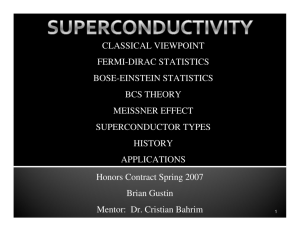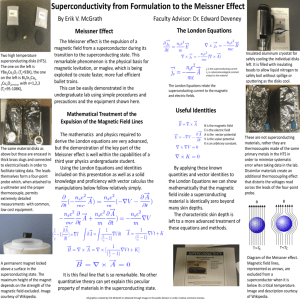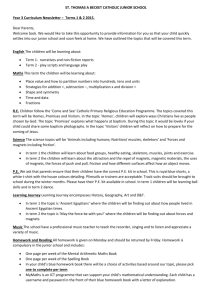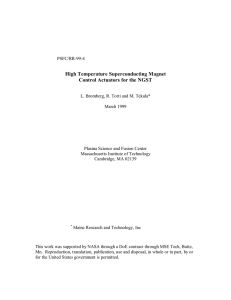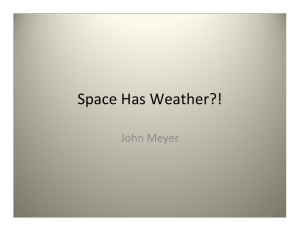Multipole Magnets Using Monolithic High Temperature Superconductor Materials: I Quadrupoles
advertisement
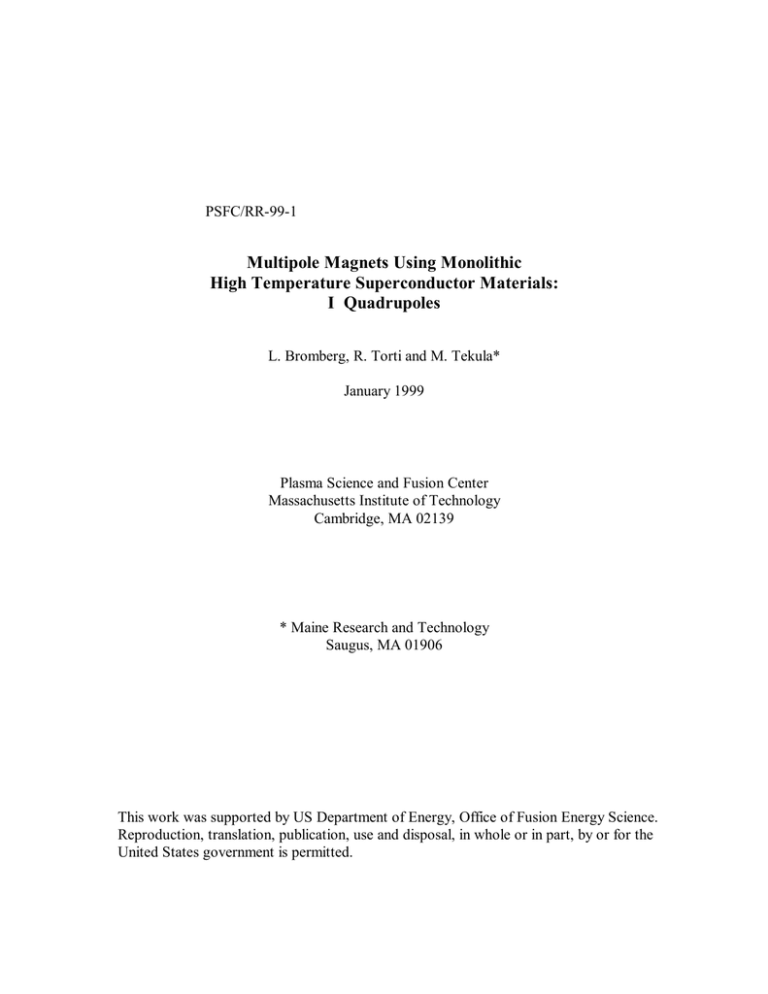
PSFC/RR-99-1
Multipole Magnets Using Monolithic
High Temperature Superconductor Materials:
I Quadrupoles
L. Bromberg, R. Torti and M. Tekula*
January 1999
Plasma Science and Fusion Center
Massachusetts Institute of Technology
Cambridge, MA 02139
* Maine Research and Technology
Saugus, MA 01906
This work was supported by US Department of Energy, Office of Fusion Energy Science.
Reproduction, translation, publication, use and disposal, in whole or in part, by or for the
United States government is permitted.
Abstract
The use of monolithic high temperature superconductors in multipole configurations is
analyzed in this paper. The properties of monolithic high temperature superconductors
have been well documented, and monolithic tubes, disks and rods of different cross
section and sizes can presently be obtained from several commercial vendors. In this
paper, design issues of quadrupole magnets using single crystal or highly textured YBCO
monoliths are addressed. The excellent properties of YBCO operating at elevated
temperatures (> 10 K) are also summarized. High field, cryo-stable, highly complex
multipole magnets can be manufactured in the proposed manner. The charging schemes
for the disks, based upon induction, are also addressed.
2
I. Introduction
High temperature superconducting (HTS) materials are ceramic and brittle in nature. The
development of long lengths of wires or tapes suitable for winding magnets has limited
the application of high-temperature superconductors. The same solutions associated with
high performance A-15 superconductors (such as Nb3Sn) are being pursued in the
fabrication of HTS wires. Presently, the wires and tapes have small superconductor
fraction, with a large decrease of the “engineering” current density. The nonsuperconducting fraction is a requirement of the fabrication process, rather than driven by
design considerations. In addition, joints between wires/tapes are also difficult to
prepare.
On the other hand, bulk HTS materials have been manufactured in large sizes. These
materials are either single crystal or multiple crystals, with currents flowing across the
grains. In particular, BSCCO 2212 and YBCO-123 have shown excellent characteristics
at low to intermediate temperatures and high fields. YCBO has impressive performance
even at high temperatures.
BSCCO 2212 shows good intergrain current transfer even though the intragrain current
density is substantially smaller than that for the YBCO materials. The BSCCO bulk
material is being fabricated for applications as current leads in superconducting magnets
and for current interrupters [Bock, Elschner, Herrman, Albrecht]. The YBCO material
has also been used for current leads for both SMES [Neimann] and for superconducting
magnets [Hull], and is being manufactured as levitators [Ohyama]. The most impressive
performance of YBCO at 77 K has been obtained by the group in Texas [Ren, Chen,
Weinstein]. In addition, YBCO flat disks have been manufactured by Boeing
[Blohowiak], and are available from commercial vendors [Aventis (Frankfurt),
Superconducting Components (Illinois), among others].
In the past, solenoidal and dipole-type magnets from high temperature superconducting
BSCCO 2212 tubes were tested by the MIT/MRAT group. The BSCCO bulk material
tested was manufactured in the shape of hollow cylinders. YBCO disks have also been
tested. The superconducting material is near single crystal in the case of YBCO, while it
is textured in the case of BSCCO 2212.
Since the bulk HTS materials do not have leads, they are referred as monoliths. The
superconducting monoliths are charged by induction, using externally applied magnetic
fields. In the past, the MIT/MRAT team has tested solenoids with a self generated 3 T,
and inserts producing a net 21 T in a 20 T background field. In addition, a 1.2 T selfgenerated dipole magnet, and a 5 T dipole in a 4 T background have been successfully
tested
The behavior of the high Tc magnets differs from that of typical A-15 superconductors.
At low ramp rates (rate of variation of an externally applied field) and at critical
conditions, the magnetic field can be made to flow in the superconductor without
quenching. At high ramp rates and low temperatures, the magnets experience quench-
3
like phenomena, but recover before all the current has disappeared. At the higher
temperatures, the magnets do not experience quench-like phenomena at the fastest ramp
rates that we have tested.
In this paper, the issues of designing quadrupole magnets using YBCO disks are
discussed. The design options are investigated, exploring the design space. Special
attention is given to exploring the resulting magnetic field geometry, including the
gradients and undesirable harmonics. The methods of charging the monoliths are briefly
reviewed. Finally, the conclusion summarizes the work and describes applications were
monolithic, high temperature superconducting magnets may offer attractive options for
the design of high field quadrupoles.
II. YBCO properties.
The properties of YBCO 123 have been determined by several teams. The most
impressive results have been obtained by the teams in Texas [Sawh] and in Japan
[Ohyama].
Measurements of YBCO-123 properties at several temperature as a function the magnetic
field are shown in Figure 1 [Maley]. These results were obtained for highly textured
tapes, and show the difference in the behavior of these highly anisotropic
superconductors to fields that are applied either perpendicular or parallel to the main
plane in the crystal.
Figure 1. Critical current density for YBCO-123 as a function of field, for several
temperatures and for different orientation of the field with respect to the crystal.
4
We will assume properties obtained by the group in Texas [Sawh] using monolithic disks.
In those studies, the field on the surface of a 30 mm diameter disk, 10 mm thick, was on
the order of 10 T at 55 K. Assuming that the current density is not a strong function of
the field, it is possible to calculate the critical current density in the superconductor at this
temperature. Figure 2 shows the contours of constant magnetic field and the flux lines
for a sample of the size used in the experiments. With a peak field at the surface of the
superconducting monolith of 10 T, the current density in the superconductor, at field and
at 50 K, is 1.67 109 A/m2. The peak magnetic field, which occurs inside of the
superconductor, is on the order of 16 T.
Figure 2. Contours of constant magnetic field and flux lines for a YBCO sample,
assuming a uniform current density of 1.67 109 A/m2.
It should be noted that this performance is comparable to the non-copper current density
of Nb3Sn superconductor, at 4 K and 10 T. Indeed, once the structure and
stabilizer/quench protection is included in the Nb3Sn designs, the average current density
is substantially lower than that for YBCO at elevated temperatures.
Some of the difficulties of using low temperature superconductors are solved by the use
of high temperature superconductors at higher temperature. The problems of flux
jumping and coupling losses that at low temperatures require the fabrication of
filamentary superconductors, can avoided by operating HTS materials at the higher
temperatures. However, manufacturing issues of the tapes/wires, as well as their use in
winding magnets, may require that HTS wires be fabricated using filamentary
superconductors or thin films on tapes.
An alternative approach, investigated in this report, is to use monolithic HTS. In the next
section, the possibilities of using bulk HTS in quadrupole magnets are explored.
5
III. Quadrupole magnet design using HTS monoliths.
Figure 3 shows a schematic diagram of a scheme to make a quadrupole magnet using
bulk HTS. The design is similar to that using permanent magnets.
Figure 3. Schematic diagram of quadrupole magnet using HTS monoliths.
The size of the commercially available monoliths has increased with time. Inexpensive
commercial monoliths of 25 mm are available from several vendors, and 100 mm wafers
are manufactured at research laboratories [Ohyama]. The size limitation of the monoliths
limits the maximum size of the quadrupole magnet.
The localized, non-uniform magnetic fields in multipoles result in forces that are unusual.
The forces are similar to those that appear when permanent magnets are used for
manufacturing the multipole magnet. A useful analogy is to assume that the HTS
materials behave as permanent magnets with a very low Curie temperature (the critical
temperature of the superconductor). From symmetry, it can be concluded that the forces
on the superconducting disks are radially directed (no net torque). Additionally, the
forces result in tension loads in the superconducting material, which are large but have
been shown that can be supported by the HTS material itself, without the use of external
support. This may not be the case when several of these disks are stacked upon each
other. The radially inward forces can be supported by placing wedges in-between the
magnets, as shown in Figure 3.
6
There are three advantages to using HTS materials for making multiple magnets as
opposed to using permanent magnets. The first advantage is the much higher current
densities that can be produced using the HTS superconducting magnets. The effective
magnetization in typical permanent magnets can alternatively be described as current
loops with an equivalent current density of only about 108 A/m2 even for the best
permanent magnet materials, vs. the much higher current density (more than an order of
magnitude larger) for the HTS materials. A second advantage is that the maximum field
in permanent magnets is limited to about 1 T, vs. the much higher fields in the HTS
materials. A final advantage is that the multipole can be assembled at room temperature
(with the pieces not charged), and then charged after assembly, while multipoles with
permanent magnets need to be assembled with special tools to handle the large loads.
IV. Parametric analysis of quadrupole magnets.
In this section, a parametric analysis for the design of quadrupole magnets is performed.
It is assumed that the required bore of the magnet is 10 cm radius (cold bore), with
magnets located on the 10 cm radius surface.
Several cases have been analyzed. The number of elements that are placed next to each
other to make a pole, np, has been varied between 1 and 5 (np= 3 in Figure 3). The
number of elements that are stacked upon each other, (nr), has been varied from 1 to 2 (nr
= 1 in Figure 3). To make a quadrupole, the magnets on opposite sides of the quadrupole
have the same polarity facing the axis.
Figure 4. Contours of constant magnetic field and flux lines for a quadrupole
configuration, assuming 1.67 109 A/m2 current density.
7
The case with a single disk at each pole of the quadrupole (np=1, nr-1) is shown in Figure
4. Due to symmetry, only one quadrant needs to be shown. It has been assumed that the
current density is the same as in the case of the single disk. Also, it has been assumed
that the problem is independent of the z-coordinate, coming out of the paper. This
implies that instead of disks, the superconducting material is manufactured in the shape
of square rods (parallelepipids).
If the field is exclusively quadrupole-like, the field components are given by Bx ~ r cos θ
and By ~ r sin θ, where θ is the poloidal angle and r is the radius. The x-y system can be
defined (by rotation) in order to satisfy the relation for Bx and By. Therefore the value of
mod B (|B| = (Bx2+By2)1/2) scales linearly with radius, independent of angle. A method of
comparing performance of superconducting quadrupoles is to calculate the value of the
coefficient A, where A = |B|/r.
The coefficient A has been calculated as a function of the number of disks that are placed
at each pole (np), and as a function of the number of the number of the thickness of the
disks placed at the poles (nr). The results of these calculations are shown in Figure 5.
As can be expected the scaling is less than linear with either the number of the disks
stacked along each other, since the disks away from the center of the pole are less
effective in generating the field than the one placed at the center of the pole. Similarly,
the disks that are stacked on top of the ones placed at a radius of 10 cm are farther away
(at 11 cm) and therefore are less effective. A fit to the field coefficient indicates a scaling
approximately given by A ~ t0.93 where t is the thickness of the disk stack. It should be
pointed out that the peak field of the doubly stacked superconductors is higher than 18 T,
and is hard to induce.
0.3
nr = 1
nr = 2
Field coefficient A (T/cm)
0.25
0.2
0.15
0.1
0.05
0
0
1
2
3
4
5
6
Number of sections, np
Figure 5. Field coefficient as a function of the number of disks placed next to each other
and as a function of the number of disks stacked on top of each other.
8
The magnetic field distribution in the case of the double stacked disks is shown in Figure
6 for the case nr = 2, np = 4.
Figure 6. Case of 4 sets of doubly stacked disks at each pole. The peak field is around 16
T.
V. Field purity.
In this section, the field purity of the quadrupole magnets made of monolithic
superconductors is investigated.
As mentioned before, the field scales as |B| ~ r, where r is the radius. However, since
there are other harmonics generated by the disks, the field does not behave linearly with
r. Figure 7a shows |B| as a function of r. The magnetic field is shown at two poloidal
locations: at the midline of the pole as well as midway between poles. The field scales
linearly to about 6 cm, where substantial deviations from linear are observed. It is
possible to improve the performance by either shaping the rods (parallelepipids) or by
placing them differently in the poloidal direction. We have not attempted to optimize the
design as much as to explore the main characteristics of this type of magnet design.
In order to investigate the behavior of the field as a function of the azimuthal angle, the
ratio of |B| to <|B|>, the poloidal average of |B| at a fixed radius, was calculated as a
function of radius. As discussed above, for a pure quadrupole |B|~ (Bx2 + By2) 1/2 is
independent of θ. The measure by which |B| is not independent of θ can be used as a
measure of non-quadrupole behavior. Figure 7b shows the maximum and minimum
value of |B|/<|B|> for θ between 0 and π/2, as a function of radius. For small values of
9
the radius, the deviation from quadrupole is small, less than about 0.5% for r ~ 4 cm. It
scales strongly with the radius. For the case in Figure 7b, the error scale as ε~ (1+r5).
2
1.8
at pole location
1.6
Mod B (T)
1.4
in-between poles
1.2
1
0.8
0.6
0.4
0.2
0
0
1
2
3
4
5
6
7
8
radius (cm)
(a)
1.15
1.1
max, min |B|/<|B|>
at pole location
1.05
1
0.95
in-between poles
0.9
0.85
0.8
0
1
2
3
4
5
6
7
8
9
radius (cm)
(b)
Figure 7. (a) Radial dependence of |B| underneath and in-between poles. (b) Radial
variation of max{|B|/<|B|> and min(|B|/<|B|>) as a function of poloidal angle.
Finally, Figure 8 shows the behavior of |B|/<|B|> as a function of the poloidal angle θ at a
fixed radius, for several values of the radius. It is obvious that there are higher order
harmonics generated, and the their contribution increases with increasing radius.
10
1.6
1.4
Mod B (T)
1.2
4
5
6
7
8
9
1
0.8
0.6
0.4
0
10
20
30
40
50
60
70
80
90
100
phi
Figure 8. Poloidal variation of |B| for several radii.
VI. Charging/discharging of the superconductor.
A. Charging Mechanism
Inducting charging of superconducting monoliths (bulk material) has been attempted
even with low temperature superconductors. The technique of flux trapping was used by
a Stanford University group in the 1970's to study the persistent magnetic field trapped in
low-Tc superconductors [Rabinovich]. Recently, flux trapping has been studied YBCO
at high and low temperatures, and for BSCCO at high temperature. The most impressive
performance of flux trapping with YBCO at 77 K has been obtained by the group in
Texas [Ren, Chen, Weinstein]. High fields, as high as 10 T at 50 K, can be produced
with YBCO single crystal disk about 25 mm in diameter and 10 mm thick.
The charging mechanism used in the past consists of applying a magnetic field when the
material is not superconducting, the decreasing the temperature until the material is
superconducting, and then removing the externally applied field [Ren, Chen, Weinstein].
This manner of charging, known as field freezing, is not convenient, as the sample needs
to be cooled quickly, resulting in large thermal stresses. Cracks can develop during the
cooling period. In addition, it is necessary to increase the temperature of the
superconductor in order to alter the magnetic field. Finally, since the cooling is relatively
slow, the external magnet field needs to be applied for long times (many seconds),
complicating the design of the charging coils.
11
For the present magnets, a different manner of charging will be used. The basic principle
consists in bringing the superconductor to its critical state at near-constant temperature by
applying additional fields/currents. Once in the critical state, magnetic flux can freely
move in-and-out of the superconductor (flux pumping), with some dissipation (resulting
in small increases in temperature due to the large thermal capacity at the temperatures of
interest (20-50 K). The HTS material at these temperatures does not experience
quenching, and little evidence of flux jumping has been observed.
The superconductor can be driven critical with the charging coil itself (flux pumping), or
by a second set of coils that induce large enough currents in the superconductor that the
critical state is reached at lower fields (saturation pumping). For the case of saturation
pumping, the saturation coil is made from a toroidal winding around the superconductor.
An attractive feature of this charging mechanism is that fast pulsed coils can be used,
simplifying the design of the charging coils.
It is important to match the superconductor to the application, because of the need to raise
it to its critical state. YBCO material has very high critical current density and fields at
the temperatures of interest (20-40 K), and is difficult to machine (self fields on the order
of 10 T for 10-20 mm diameter disks). BSSCO-2212 material on the other hand, is easy
to machine but has lower critical current ~ 108 A/m2. For the present application, YBCO
bulk material is superior.
B. Charging Circuit
Figure 9 shows a simple schematic of the electrical circuit. A power supply is used to
charge a capacitor, which is discharged through the charging coil L1. The
superconductor is represented as an inductor L2 in series with a variable resistor. The
variable resistor limits the current flowing in the superconductor to below or equal to
critical current (the value of the resistor varies automatically). The variable resistor has
zero resistance when the superconductor is away from critical.
This is a figure
Figure 9. Schematic diagram of power supply
It is assumed that the charging coil and the high-Tc tube have good coupling coefficient.
The currents in the charging coil and the induced current in the high-Tc monoliths are
shown in Figure 10. As the switch is closed, since the coils are well coupled, the circuit
looks like a short circuit, and the current raises rapidly. Increases in current in the
12
charging coil are balanced by opposite changes in current in the superconductor. As the
high-Tc superconductor reaches critical conditions, the current in the superconductor
remains steady at critical, and the load suddenly looks inductive, slowing down the rate
of rise of the current. The circuit looks like a coupled capacitor-inductor system, with an
LC time constant. After the charging circuit current reaches the maximum current and
the current starts decaying, the superconductor is moved away from the critical condition,
and suddenly the inductive load disappears and the circuit becomes a short circuit, with
zero voltage but large current. With no driving voltage, the current in the charging coil
decreases very fast, without oscillations. The final result is that the energy in the
capacitor, minus the energy dissipated in the charging and superconducting coils, is
transferred to the inductor.
The process can be repeated until the right current in the superconductor is reached, as
long as it is below the critical current. The discharging process is the opposite, with the
capacitor charged in the reverse direction.
The switch can be a semiconductor switch, realized with either a fast IGBT or a high
power MOSFET. It is also necessary to match the impedance of the load by using a
transformer between the power supply and the charging coil.
CURRENT (arb. units)
charging current
superconductor current
I_critical
TIME (arb untis)
Figure 10. Current waveforms in charging and superconducting coils
13
VII.
Conclusion
The possibility of using high temperature superconductors as elements generating
multipole fields has been described. There are several advantages for this type of
manufacturing. First, the average current density in the superconductor is substantially
higher than for low-Tc superconductors or equivalent current density in permanent
magnets, resulting in higher field gradients. The maximum field is higher than possible
with LTS or permanent magnets. The system can be assembled prior to magnetization,
something that can not be done when using permanent magnets. The monoliths can be
presently acquired from several vendors, who are selling them mainly as levitators.
These monoliths are nearly single crystal.
It has been demonstrated that the HTS bulk material does not experience flux jumping or
quenching at temperatures higher than 10 K. Therefore, there is no need for stabilizer or
quench protection. Instead of flux jumping or quenching, the superconductor goes
through a flux-flow period, excluding the field until it reaches critical conditions.
Because of the size availability of these disks, for large quadrupole radii it may not be
cost effective to manufacture the multipoles using YBCO monoliths. If the size of the
magnet increases substantially beyond that used in this paper, the attractiveness of the use
of monolithic high temperature superconducting elements decreases substantially. This
can be explained as follows: the monoliths placed next to each other in a pole (when
np>1) have currents flowing in opposite directions in adjacent section of adjacent
monoliths. To zeroth order, these currents cancel, leaving only the currents in the outer
section of the outermost monoliths (on both sides) of each pole. Therefore, as np, the
number of monoliths that are placed next to each other increases, the average effective
current density decreases (inversely proportional to the number of monoliths). Thus, if
the radius of the magnet is large compared to the size of the monoliths, the effective
current density decreases and the use of monoliths becomes less attractive.
The above discussion is relevant for long quadrupoles, or when many quadrupoles are
needed, as in long beam lines. For short quadrupoles, the advantage of using high
temperatures, with many monolithic magnets, may still be
We empirically understand the process for charging the monoliths. It is possible to
charge them to their locally critical state without quenching. For applications where it is
important to maximize the use of the superconductor (i.e., with high average current
densities), this mode of charging is particularly relevant. These magnets could find uses
in accelerator physics (if the field errors can be controlled), in Electron-Cyclotron
Resonance Ion Sources (ECRIS), or in other general physics applications where high
current density and high field is needed in compact systems.
The proposed technique opens the possibility of manufacturing multipole magnets with
HTS materials in the near term. It may provide a method of manufacturing compact
multipole magnets, even in the long term, by avoiding the need of bending HTS wires or
tapes to small dimensions.
14
References
[Bock] Bock, J.; Bestgen, H.; Elschner, S.; Preisler, E., Large shaped parts of melt cast
BSCCO for applications in electrical engineering, IEEE Trans. Appl. Supercond. (USA)
3 1 p. 1659-62, March 1993
[Elschner] Elschner, S., Bock, J., Bestgen, H., Influence of granularity on the critical
current density in melt-cast processed Bi2Sr2CaCu2Ox, Superconduct Sci & Tech 6, p.
413-20, June 1993
[Herrman] Herrmann, P.F., Beghin, E., Bottini, G., Cottevieille, C., Leriche, A.,
Verhaege, T., Bock, J., Test results of a 1 kA (2 kA)-20 kV HTSC current lead model,
Cryogenics 34, 6 p. 543-8, June 1994
[Albrecht] Albrecht, C., Bock, J., Herrmann, P.F., Tourre, J.M., Current leads-first
applications of high Tc superconductors for power devices, Physica C (Netherlands),
235-240, pt.1, p. 205-8, Dec. 1994
[Neimann] Niemann, R.C., Cha, Y.S., Hull, J.R., Buckles, W.E., Daugherty, M.A.,
Weber, B.R., High-temperature superconducting current leads for micro- SMES
application, IEEE Trans. Magn. 30, p. 2589-92, July 1994
[Hull] Niemann, R.C., Cha, Y.S., Hull, J.R., Performance measurements of
superconducting current leads with low helium boil-off rates, IEEE Trans. Appl.
Supercond 3, p. 392-5, March 1993
[Ohyama] Ohyama, T., M. Itoh, T. Minemoto and K. Hoshino, Improvements in
Magnetic Shielding by use of a Triple-Cylinder Configuration of Superconducting
BPSSCO, in Adv. Cryo. Eng., R.P. Reed, ed., 40 245 (1994)
[Ren] Ren, Y.; Liu, J.; Weinstein, R.; Chen, I.G.; Parks, D.; Xu, J.; Obot, V.; Foster, C.,
Quasi permanent superconducting magnet of very high field, J Appl Phys 74, p. 718-19,
July 1993
[Chen] In-Gann Chen; Jianxiong Liu; Yanru Ren; Weinstein, R.; Kozlowski, G.; Oberly,
C.E., Quasipermanent magnets of high temperature superconductor: temperature
dependence, Appl Phys Lett 62, p. 3366-8, June 1993
[Weinstein] Weinstein, R.; Chen, I.G.; Liu, J.; Narayanan, R.; Ren, Y.R.; Xu, J.; Obot,
V.; Wu, J., Materials, characterization, and applications for high Tc superconducting
permanent magnets, Appl. Supercond 1, p. 1145-55, July-Sept. 1993
[Maley] Maley, M.P. et al., Optimization of Transport critical current in HTS
Conductors, in 1996 Annual Peer Review Meeting, U.S. Department of Energy,
Washington D.C. (July 31, 1996).
15
[Blohowiak] Blohowiak, K.Y., D.F. Garrigus, T.S. Luhman, K.E. McGrary, M. Strasik et
al., Evaluation of YBCO Bulk Superconductors for High Field Magnet Applications
[Sawh] Sawh R-P, Ren Y, Weinstein R, Hennig W, Nemoto T. Uranium chemistry and
pinning centers in high temperature superconductor. Physica C,.305, no.3-4, pp.159-166,
1 Sept. 1998.
16
